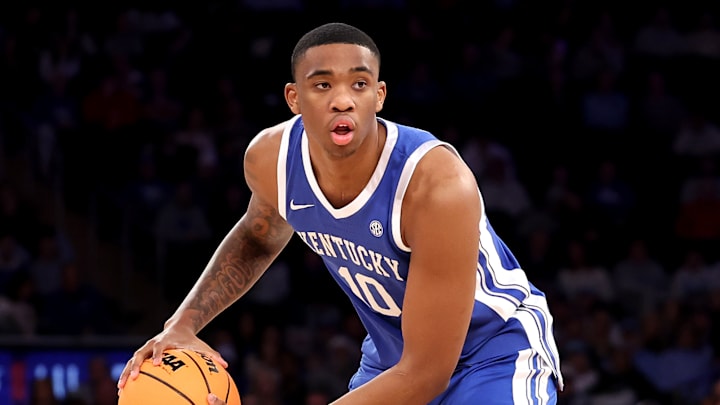Kentucky basketball’s struggles this season highlight recurring issues contributing to their defeats against Georgia (82-69), Ohio State (85-65), and Clemson (70-66). A closer look at these games reveals key themes: poor shooting, inconsistent rebounding, and a lack of focus in crucial moments.
1. Shooting Woes
Kentucky’s inability to consistently hit shots has been a significant issue. Against Ohio State, the Wildcats shot a dismal 29.8% from the field and just 18.2% from three-point range. Similar struggles were evident against Georgia (37.5% FG, 24.0% 3PT) and Clemson (38.1% FG, 25.9% 3PT).
The Wildcats have relied heavily on three-point shooting, but their inefficiency from beyond the arc has cost them momentum. For example:
- Georgia Game: Kentucky went 6-for-25 (24.0%) on three-point attempts, unable to match Georgia’s slightly better 7-for-24 (29.2%).
- Clemson Game: Kentucky’s 7-for-27 (25.9%) performance from deep was outshined by Clemson’s 8-for-25 (32.0%).
Mark Pope does not want them to focus on makes and misses, but the process; Kentucky has yet to get to his desired 35 shots from deep per game.
2. Inconsistent Rebounding
While Kentucky fought back on the boards against Clemson after being dominated in the first half, grabbing 44 rebounds (15 offensive), they struggled in critical moments. Both teams had identical rebounding numbers, indicating a lack of separation in a key area of the game.
Against Georgia, Kentucky lost the rebounding battle 41-34, including allowing 13 offensive rebounds. Mark Pope emphasized this issue postgame, calling the rebounding lapses "unacceptable" and attributing them to a lack of focus.
Against Ohio State, Kentucky secured 13 offensive rebounds but failed to capitalize, as the Buckeyes’ efficiency minimized second-chance opportunities.
3. Free Throw Reliance Without Conversion
While Kentucky has excelled in drawing fouls and getting to the line, their performance hasn’t been consistent.
- Clemson Game: The Wildcats shot 11-for-18 (61.1%) from the free-throw line, a stark contrast to Clemson’s 14-for-19 (73.7%).
- In contrast, they converted 27-for-32 (84.4%) against Ohio State, their one bright spot in an otherwise tough loss.
This inconsistency at the charity stripe has turned a potential strength into a liability. And teams are taking advantage as they have a +30 free throws taken in the SEC games so far.
4. Turnovers and Decision-Making
Turnovers haven’t been Kentucky’s most glaring issue, but poor decision-making in critical moments has hurt.
- Against Georgia, Kentucky turned the ball over 14 times, leading to 13 Georgia points off turnovers.
- In the Clemson game, their 12 turnovers translated into 7 Clemson points—small margins that proved decisive in a close contest.
Additionally, Kentucky’s offensive possessions often stall when they fail to move the ball effectively. Their 8 assists against Georgia and 11 against Ohio State and Clemson reflect a lack of fluidity, particularly in half-court sets. For reference, Kentucky averages 20 assists a game on the season.
5. Defensive Struggles in Transition and on the Glass
Pope also highlighted defensive lapses in transition, saying, “We lost a little bit in transition. It was so hard to actually get a defensive rebound where it wasn’t a foul.”
Against Ohio State, the Wildcats allowed 36 points in the paint, reflecting a defensive breakdown in protecting high-percentage areas. Clemson also found success inside, scoring 26 points in the paint, capitalizing on Kentucky’s lapses.
Conclusion: Building Habits, Avoiding Distractions
Mark Pope’s postgame comments after the Georgia loss resonate across all three games. He noted that “distraction” and uncharacteristic plays were holding the team back, adding, “Sometimes, when you start on a project, you take 10 steps backward before you make progress.”
Kentucky’s path forward hinges on addressing these themes:
- Improving shot selection and execution against pressure teams.
- Becoming more disciplined and physical on the boards.
- Maintaining focus and composure during high-pressure moments, eliminating careless turnovers.
If the Wildcats can correct these issues, they have the talent and coaching to rebound from their early setbacks. However, these losses serve as a reminder that potential must be matched with execution to achieve success.
